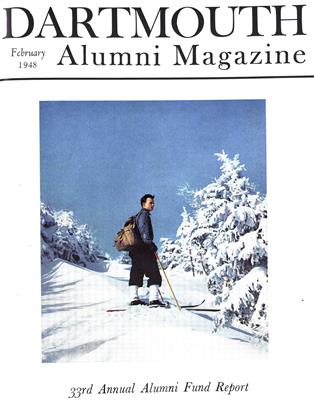by William Nelson Fenton '31.American Council on Education, 1947,Foreword and 89 pages, $1.00.
By the summer of 1943, the Foreign Area and Language Study Curriculum had been organized to form a part of the Army Specialized Training Program and the Army Civil Affairs Training Program and to it were assigned trainees..for the military police and the military government of occupied and conquered areas. This curriculum was the first attempt on the collegiate level "to combine in an integrated area study the methods of the social sciences and the subject matter of the humanities for working out the total culture or civilization of a region." Recognizing that such an approach might influence in a significant manner the post-war organization and instruction in the social sciences and related disciplines, Dr. William Nelson Fen ton, a member of the staff of the Bureau of American Ethnology, and Miss Elizabeth Bacon, an anthropologist and teacher in the Far Eastern program at the University of Washington, were asked to conduct a survey of the major area programs which were in operation in some of the American colleges and universities. Twenty seven institutions in all parts of the country were visited. In "Area Studies in American Universities," Dr. Fenton summarizes their findings and in the final chapter, "Implications for Future Area Studies" discusses some of the major changes in curriculum organization and in methods of instruction which would accompany an extensive introduction of studies of this sort. In the first place, he states that by realigning the subject matter fields involved—geography, history, government, and natural history, and concentrating them as parts of topics dealing with the total culture of a region, integrated area study would threaten traditional departmental organization and would accelerate the trend toward fewer courses in the liberal college. Secondly, the methodology of the area study would challenge the strong position which the historical method holds in academic thinking and, instead, would offer concentration on the present situation and would call on the method of the culture historian to explain the major aspects of a current civilization, delving into the past only to the extent necessary to make the present understandable. Finally, area study would permit the student to gain an understanding of a foreign culture through several branches of learning rather than through any one.
"Area Studies in American Universities" is a companion to another similar study,
"Language and Area Studies in the Armed Services: Their Future Significance," prepared by Dr. Robert John Matthew. It is a stimulating and interesting resume of the contributions, both actual and potential, of area studies as a method of organizing and teaching integrated courses in the culture of a region. It leaves one with the feeling that here is an approach that promises better understanding of strange and foreign cultures and people.
 View Full Issue
View Full Issue
More From This Issue
-
 Article
ArticleATOMIC ENERGY CONTROL
February 1948 By CHESTER I. BARNARD, -
 Class Notes
Class Notes1949
February 1948 -
 Class Notes
Class Notes1918
February 1948 By ERNEST H. EARLEY, DONALD L. BARR, DAVID L. GARRATT -
 Class Notes
Class Notes1935
February 1948 By H. REGINALD BANKART JR., FREDERICK T. HALEY, ROBERT W. NARAMORE -
 Class Notes
Class Notes1931
February 1948 By A. W. LAUGHTON, WILLIAM H. SCHULDENFREI, ERNEST H. MOORE -
 Class Notes
Class Notes1924
February 1948 By JAMES T. WHITE, RICHARD A. HENRY, DONALD E. COYLE
Books
-
 Books
BooksTHE STRIDE OF TIME.
APRIL 1967 By ALEXANDER LAING '25 -
 Books
BooksBriefly Noted
MAY 1970 By F.H. -
 Books
BooksTOUGH TRIP THROUGH PARADISE.
OCTOBER 1967 By GEORGE O'CONNELL -
 Books
BooksTHE ROSE BATH RIDDLE
October 1934 By John Hurd Jr. '22 -
 Books
BooksTHE STORY OF AMERICAN DISSENT.
November 1934 By Malcolm Keir -
 Books
BooksVITAL PROBLEMS OF CATHOLIC EDUCATION IN THE UNITED
April 1940 By William F. Geiger '92.


